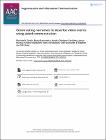| dc.contributor.author | Smith, Martine | |
| dc.date.accessioned | 2020-07-15T11:20:07Z | |
| dc.date.available | 2020-07-15T11:20:07Z | |
| dc.date.issued | 2018 | |
| dc.date.submitted | 2018 | en |
| dc.identifier.citation | Smith, M.M., Batorowicz, B., Dahlgren Sandberg, A., Murray, J., Stadskleiv, K., van Balkom, H., Neuvonen, K. & von Tetzchner, S,, Constructing narratives to describe video events using aided communication, Augmentative and Alternative Communication, 2018, 34, 1, 40 - 53 | en |
| dc.identifier.issn | 0743-4618 | |
| dc.identifier.other | Y | |
| dc.identifier.uri | http://hdl.handle.net/2262/92998 | |
| dc.description | PUBLISHED | en |
| dc.description.abstract | Narratives are a pervasive form of discourse and a rich source for exploring a range of language and cognitive skills. The limited research base to date suggests that narratives generated using aided communication may be structurally simple, and that features of cohesion and reference may be lacking. This study reports on the analysis of narratives generated in interactions involving aided communication in response to short, silent, video vignettes depicting events with unintended or unexpected consequences. Two measures were applied to the data: the Narrative Scoring Scheme and the Narrative Analysis Profile. A total of 15 participants who used aided communication interacted with three different communication partners (peers, parents, professionals) relaying narratives about three video events. Their narratives were evaluated with reference to narratives of 15 peers with typical development in response to the same short videos and to the narratives that were interpreted by their communication partners. Overall, the narratives generated using aided communication were shorter and less complete than those of the speaking peers, but they incorporated many similar elements. Topic maintenance and inclusion of scene-setting elements were consistent strengths. Communication partners offered rich interpretations of aided narratives. Relative to the aided narratives, these interpreted narratives were typically structurally more complete and cohesive and many incorporated more elaborated semantic content. The data reinforce the robust value of narratives in interaction and their potential for showcasing language and communication achievements in aided communication. | en |
| dc.format.extent | 40 | en |
| dc.format.extent | 53 | en |
| dc.language.iso | en | en |
| dc.relation.ispartofseries | Augmentative and Alternative Communication; | |
| dc.relation.ispartofseries | 34; | |
| dc.relation.ispartofseries | 1; | |
| dc.rights | Y | en |
| dc.subject | Narratives | en |
| dc.subject | Aided communication | en |
| dc.subject | Video events | en |
| dc.subject | Narrative Assessment Profile | en |
| dc.subject | Narrative Scoring Scheme | en |
| dc.title | Constructing narratives to describe video events using aided communication | en |
| dc.type | Journal Article | en |
| dc.type.supercollection | scholarly_publications | en |
| dc.type.supercollection | refereed_publications | en |
| dc.identifier.peoplefinderurl | http://people.tcd.ie/mmsmith | |
| dc.identifier.rssinternalid | 182569 | |
| dc.identifier.doi | http://dx.doi.org/10.1080/07434618.2017.1422018 | |
| dc.rights.ecaccessrights | openAccess | |
| dc.subject.TCDTheme | Identities in Transformation | en |
| dc.subject.TCDTheme | Inclusive Society | en |
| dc.subject.TCDTag | Augmentative and Alternative Communication | en |
| dc.subject.TCDTag | Language Acquisition (first & second) | en |
| dc.identifier.orcid_id | 0000-0003-2122-5607 | |
| dc.subject.darat_impairment | Physical disability | en |
| dc.subject.darat_thematic | Children | en |
| dc.subject.darat_thematic | Communication | en |
| dc.status.accessible | N | en |




